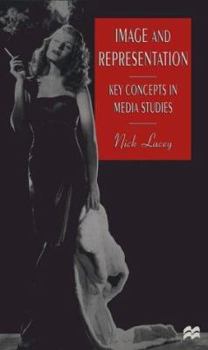Image and Representation
Select Format
Select Condition 
Book Overview
Image and Representation is a clear and straight-talking introduction to two of the most important concepts in film and media studies. Exploring media language and representation throughout a variety... This description may be from another edition of this product.
Format:Paperback
Language:English
ISBN:0312212038
ISBN13:9780312212032
Release Date:January 1998
Publisher:Palgrave MacMillan
Length:256 Pages
Weight:0.80 lbs.
Dimensions:0.6" x 5.4" x 8.4"
Customer Reviews
2 ratings
At last!
Published by Thriftbooks.com User , 22 years ago
At last, a straight forward foundation book on the analysis of image and representation. It covers the analysis of photography as well as that of cinema step by step. Lacey also gives precise definitons of all the components of an image, what elements are to be taken into account when, why and how. His manual covers camera techniques and semiotics with unprecedented clarity. Saussure, Barthes, Pierce and other classics in the realm of linguistics are explained and applied. The excercises he proposes for the classroom are fun and straight to the point. This book will teach everyone to read images.
Clear, concise introduction for undergraduates
Published by Thriftbooks.com User , 26 years ago
THis book is a fine and in many ways unique addition to possible choices for textbooks for an undergraduate course in critical theories of image analysis (or introduction for general readers interested in this topic). Lacey is Head of Media Studies at a post-16 school in West Yorkshire, England. This book appears to be an outcome of his own teaching at this level as well as his professed primary interest in film. Its major accomplishment is to clearly link image analysis to the field of communication, as well as to reintroduce social and historical considerations into what is too often considered either an individualist or a formalist task. Lacey emphasizes throughout that individual interpretations have a common basis determined by culture and history, and that individual images can be examined carefully in order to suggest this basis. By taking this view, Lacey avoids the "art-appreciation" trap, stressing that the goal of interpretation is to describe how images work in society, not what the proper meaning is. He also deftly minimizes the mechanistic implications of a (generally speaking) semiotic perspective by emphasizing that codes are fluid social conventions, not invariant and timeless structures.Lacey begins Chapter 1 by introducing linguist Roman Jakobson's model of communication, a six-faceted one consisting of addresser, addressee, context, message, contact, and code, to emphasize the social and contextual nature of interpretation. This is combined with a clear run-down of features of images, from nonverbal communication (such as facial expression, body gestures, and clothing) to form (such as framing, angle, height, and depth of field) and content (subject, lighting, and setting). Additional media-specific features (such as anchorage and juxtaposition) and editing are also noted. This discussion is particularly useful for students who have not taken courses in television- or film-production or in photography. All this and more takes place in the (50-page) first chapter, no less! Chapter 2, which introduces semiotic analysis via Saussure, Peirce, and Barthes, finishes the overtly methodological discussion. It does as good a job as any on a notoriously difficult topic. The remaining five chapters build upon the theoretical and descriptive basis laid down in the first two. Stronger chapters alternate between somewhat weaker ones. Chapter 4, titled "Advanced Image Analysis," introduces larger issues surrounding images (and media) in society from a cultural and critical perspective. Brief discussions of authorial intent, preferred reading, discourse, and hegemony are fleshed out with an account of alternative ways of editing and a short history of Western images and their uses in society. Similarly, Chapter 6, titled "Representation and Reality," provides a clear introduction to the emergence of realism as a way of understanding and packaging the world. The discussion ranges from a history of realis





